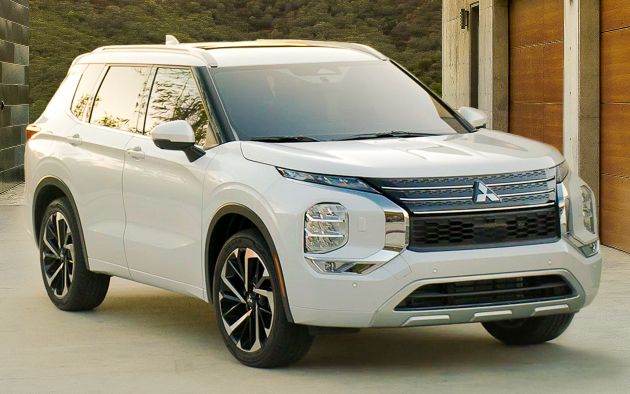It’s been a long time coming, but after nine years, a concept car, several spyshots and leaked images, Mitsubishi has finally introduced the new fourth-generation Outlander. The seven-seater SUV is all new from the ground up, sporting a completely remodelled design and up-to-date technologies.
If the styling looks familiar, that’s not only because you saw the leaks, but also because it’s been derived from the Engelberg Tourer/e-Yi Concept from 2019. The Outlander features a new “Bold Stride” design language as part of the “I-Fu-Do-Do” product concept, supposedly meaning authentic and majestic in Japanese.
The front end wears the latest interpretation of Mitsubishi’s Dynamic Shield face, already seen on the facelifted Eclipse Cross. This splits the headlights into a slim upper layer, which incorporates the daytime running lights and indicators, and larger hexagonal main lamps. The grille has also been refined with triple chrome slats and a hexagonal pattern, while a beefy skid plate design adds some aggression.
Along the side, the flared fenders give the Outlander a muscular look, while the split D-pillars afford it the trendy “floating roof” look. The hexagonal theme is continued in the side surfacing and the stamped tailgate, which is said to be inspired by the classic external spare tyre on the Pajero. The horizontal T-shaped taillights are very broad, emphasising the car’s width.
In total, there are nine body colours to choose from, including six standard hues. The rest of the paint options come from the special high-brightness Diamond range, consisting of White Diamond, Red Diamond and Black Diamond. The latter is a new three-coat finish with a high-density glass flake layer.
Step inside and you’ll find a modern horizontal dashboard that features a leather-wrapped and stitched upper layer, plus a tall centre console and freestanding infotainment touchscreen. Material selection has taken a step up, with options including semi-aniline leather upholstery and a genuine aluminium gearlever surround. The front seats also have a two-layer urethane structure to improve comfort on long journeys.
The Outlander is a family SUV first and foremost, so interior room is paramount. To that end, the body is wider and offers more legroom for first- and second-row occupants, while sliding 40:20:40-split second-row seats increase the cabin’s flexibility and practicality. Mitsubishi is also touting plenty of smartphone storage, including the centre console tray and sides, driver’s seat back and third-row side panels.
One area where the Outlander has taken a massive step forward is in in-car technologies. The car is being offered for the first time with a full 12.3-inch digital instrument display and a 10.8-inch head-up display. The highest available infotainment system comes with a nine-inch display, navigation and wireless Apple CarPlay and wired Android Auto connectivity.
Mitsubishi also plans to offer real-time traffic information and over-the-air software updates in the near future. In the meantime, you can spec the Outlander with a ten-speaker Bose sound system, 15-watt wireless smartphone charging, triple-zone automatic climate control, seat heaters and rear door sunshades. Also provided are USB-A and USB-C charging ports on the centre console.
Safety-wise, the Outlander comes with Mi-Pilot Assist, which combines adaptive cruise control with stop and go and lane centring assist to keep it a set distance from the car in front and in the centre of its own lane. Models fitted with the navigation system can set the speed using traffic sign recognition and slow the car down for corners and highway exits.



As standard, the car comes with nine airbags, including rear side airbags and a new front centre airbag between the driver and passenger. The Outlander is also fitted with Mitsubishi Connect, which adds a emergency call function and allows various vehicle features to be controlled remotely.
The Outlander is built on a new platform that utilises ultra-high tensile strength steels and hot stamping, a Mitsubishi first. You’ll also find connected cyclic structures around the engine compartment and cabin, increasing torsional and flexural rigidity over the old model. The car utilises multi-link suspension and dual-pinion electric power steering to deliver improved ride comfort and more direct and linear handling.
Also new is the 2.5 litre petrol four-cylinder engine. No details have been revealed just yet, but expect improved performance over the old 2.4 litre mill, which currently makes 167 PS and 222 Nm of torque. It’s mated to a CVT with eight virtual ratios and delivers a claimed 8.9 per cent improvement in fuel efficiency on the WLTP cycle. As before, the Outlander is available with either front- or all-wheel drive.
The AWD system utilises Mitsubishi’s upgraded Super All Wheel Control (S-AWC) technology, which shuffles power automatically from front to rear and across the front wheels. What’s new is that the Brake Active Yaw Control (AYC) now also operates on the rear wheels and is now offered even on front-wheel-drive models. All cars come with a drive mode selector with Eco, Normal, Tarmac, Gravel, Snow and Mud settings, the last of which is exclusive to all-wheel-drive variants.
Mitsubishi hasn’t revealed any details regarding a plug-in hybrid model but has already promised one for April next year. Expect the PHEV to feature the upgraded powertrain from the Engelberg, which incorporates a larger 2.4 litre engine, an electric motor on each axle and a bigger 20 kWh lithium-ion battery. Back then, Mitsubishi touted an all-electric range of more than 70 km and a total range of over 700 km.
For now, customers in the United States can purchase the Outlander starting this April, with prices starting at US$25,795 (RM104,000). It will go on sale in other global markets later on.





















































































The post 2022 Mitsubishi Outlander unveiled – Engelberg Tourer looks, wireless Apple CarPlay, larger 2.5 litre engine appeared first on Paul Tan's Automotive News.





0 Comments